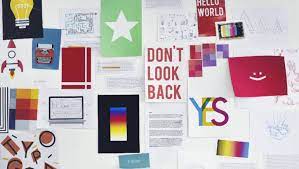A vision board is a collection of images, words, pictures, and symbols that serve as inspiration for individuals to work towards their goals. Visualization is the key idea behind vision boards, as it helps form a constant reminder of the goals in a permeable way. A vision board serves as a warm up for actions and a valuable tool for setting up a foundation for success.
A vision board is a collection or collage of images, words, pictures, and symbols that serve as inspiration to you. They can be created in various ways, from analog vision boards to virtual versions made on your computer or phone. Making a vision board gives you a creative outlet to step back and take the time to think over the goals you want to actively work toward.
The key idea behind vision boards is “visualization,” which is where you form a picture of something in your mind, or on a vision board in this case, to help you envision things you want to achieve. Visualization via a vision board can help serve as a constant reminder of your goals in a permeable way.
Visualization has been found to change how brain networks are organized, and according to Srini Pillay for Scientific American, visualization and action go hand in hand. According to Pillay, making a vision board almost serves as a little warm up for the actions you’ll need to take toward your goals. In the long-term, it is a valuable tool that helps set up a great foundation for you. It will showcase the goals that are most important to you and serve as a source of motivation as you begin taking action toward those goals.
To create a vision board, you have total freedom over it. It’s your chance to get creative, have fun, and get focused!
- Write down 2-4 goals on a piece of paper. This will give you a much clearer and manageable understanding of the goals that are most important to you at the moment. You can do this by brainstorming in a journal, chatting about your goals with a friend, making a mind map, or even talking about your goals out loud into a voice recorder.
- Find and gather your images, words, and symbols. There are so many different places you can find the images and words that you’d like to use in making a vision board, whether you’re looking for specific colors, letters, or inspiring images. For analog versions:
Magazines
Scrapbooking materials
Stickers
Online images
Newspapers
Digital versions:
Screenshots from social media
Images from royalty free websites like Pexels and Unsplash
Vision board applications
Your own personal photos
On both analog and digital vision boards, you can also include motivational quotes, words, and specific symbols that inspire you.
- Arrange your images, symbols, and words.
With your goals set and visual elements collected, the most fun part of creating a vision board can start—arranging all of your inspiration onto the vision board itself! Whether you’re making a digital or analog vision board, play around with how you’d like to arrange your elements before committing to a final layout.
- Place your vision board somewhere you’ll regularly see it. Some great places to display it include:
Office–either on or above your desk or as your computer background
Living room–either by the front door, on the fridge, or on a mirror.
To make your vision board visually appealing, there’s no one right way to do it, but it’s important that it appeals to you. To make your vision board unique to you, you can collect images, symbols, and words that you’ll enjoy looking at and tie into your set goals. Match your vision board to your personal aesthetic, such as using cooler colors or sharp lines.
Lastly, consider the size. Vision boards can be any size, from postcards to something that hangs on a wall. As you get started, remember that creating a vision board is a creative and dynamic process that’s meant to help you visualize and begin working toward important goals.
Conclusion
A vision board is a collection of images, words, pictures, and symbols that serve as inspiration for individuals to work towards their goals. It is a creative outlet that allows individuals to visualize their goals and set a foundation for their actions. Visualization has been found to change brain network organization, and making a vision board serves as a warm-up for taking action towards those goals.
To create a vision board, write down 2-4 goals on paper, gather images, words, and symbols from various sources, and arrange them on the board. Place the vision board in a place where it will be regularly seen, such as the office or living room. To make the board unique, collect images, symbols, and words that align with your set goals and match them to your personal aesthetic.
Vision boards can be any size, from postcards to wall-mounted items. Remember that creating a vision board is a creative and dynamic process that helps visualize and begin working towards important goals.



